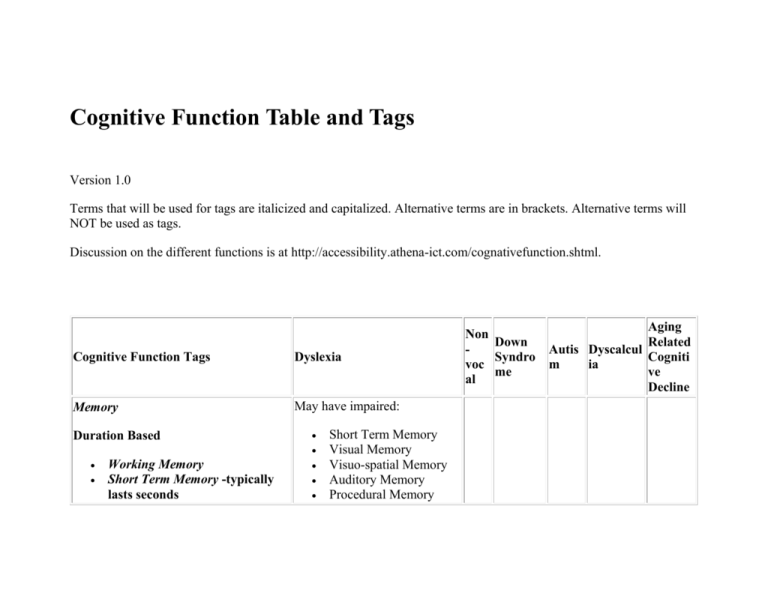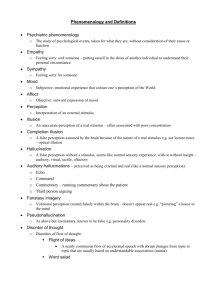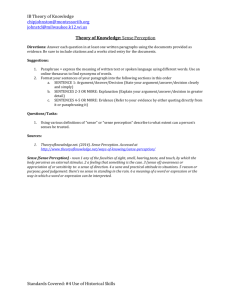Cognitive Function Table and Tags
advertisement

Cognitive Function Table and Tags Version 1.0 Terms that will be used for tags are italicized and capitalized. Alternative terms are in brackets. Alternative terms will NOT be used as tags. Discussion on the different functions is at http://accessibility.athena-ict.com/cognativefunction.shtml. Cognitive Function Tags Dyslexia Memory May have impaired: Duration Based Working Memory Short Term Memory -typically lasts seconds Short Term Memory Visual Memory Visuo-spatial Memory Auditory Memory Procedural Memory Non Down Syndro voc me al Aging Related Autis Dyscalcul Cogniti m ia ve Decline Long Term Memory - (includes recall and writing - the ability to learn such as learn a new symbol and use it the next day) Context Based Episodic Memory(autobiographical – time, self, ) Semantic Memory (factual) Visual Memory Visuo-Spatial Memory Auditory Memory: memory for sound patterns (um), Procedural Memory Musical Memory Prospective Memory remembering to do things in the future, such as keep appointments, return a book to the library, or pay bills on time Emotional Memory Awareness based Implicit memory :(nondeclarative memory ) Prospective Memory Explicit memory: (declarative memory, intentional use of memory ) Also memories can be stored and recalled as Associative memory (MA) Meaningful memory (MM) Free-recall memory (M6) Executive Functions Emotional Control and SelfMonitoring Shift ( also called task flexibility) Initiation Planning/Organization and Execution Sometimes affected: Planning/Organization Reasoning Fluid Reasoning (logical reasoning) Mathematical Intelligence Seriation - reasoning via seriation Typically not affected includingOrganization, Conservationand Classification Behavioral -(or conative) component involving memory such as long term autobiographical memory. Crystallized Intelligence(sometimes called comprehension- knowledge) is the ability to use skills, knowledge, and experience. Abstraction Attention Selective Attention -the ability to attend to some stimuli while Selective Attention may be disregarding others that are affected irrelevant to the task at hand. Divided Attention Sustained Attention Language Speech Perception Speech Literacy see below for more details Speech Perception: This depends on: Auditory Discrimination (Note not L hearing, but the identification and differentiation of sounds also called general sound discrimination (u3), Temporal Tracking (uk) Listening Ability (ls) Naming Skills (n) Morphosyntax The system of the internal structure of words (morphology) and the way in which words are put together to form phrases and sentences (syntax). Note, there is also related memory such as working memory, auditory memory -see above There is also knowledge required (see below) such as: Grammar Metaphors Lexical Often affected: Auditory Discrimination Temporal tracking Temporal tracking Naming skills Morphosyntax related memory Understanding Figural Language understanding figural language. such as a simile, onomatopoeia, personification , oxymoron, paradox, Not affected allusion or idiom and puns. This is the ability to understand figural language and does not include the knowledge of the metaphors. Literacy Depends on Speech Perception and visual perception. Also depends on: Phoneme Processing and phonetic coding (PC) Cross-Modal Association(association of sign and concept) Affected Visual Perception (visual recognition ) The visual system automatically groups elements into All can be affected patterns:Proximity, Similarity, Closure, Symmetry, Common Fate (i.e. common motion), and Continuity. (Gestalt psychology) Functions include: Object Recognition Face Recognition (seems to be a different process to object recognition [ Face and object recognition ((Alex Huk. (1999) "Object and Face Recognition: Lecture Notes." pp. 5] Visual Pattern Recognition Other Perception Auditory Perception (see Speech Perception above for further classifications), Motor Perception TactilePerception Auditory Perception affected Smell Perception Psychomotor Perception Kinesthetic Perception ( bodily position, weight, or movement) Olfactory Perception and Sensory Perception Knowledge Types of knowledge that might be required for use of ICT include: Typically not affected. Cultural Knowledge base Language Knowledgeincluding: o Lexical (UL) o Jargon (subject mater) o Web Jargon and technology o Web and TechnologyUsag es and Risks o Metaphors and idioms Symbols Knowledge(such as icons) Mathematical Knowledge Mechanical Knowledge (MK) Knowledge of Behaviors Design Metaphor Knowledge Design Functions Knowledge Behavioral Behavioral Abstractions and social – Norms etc Social Cues other Behavioral Consciousness Slightly affected: Norms and Social Cues Typically not affected. , Spoken languages The basic skills for spoken languages seem to be Speech perception: Speech perception: sounds of language are heard, interpreted and understood This depends on: Auditory Discrimination (Note not L hearing, but the identification and differentiation of sounds also called General sound discrimination (U3), Temporal tracking (UK) Listening Ability (LS) Naming skills (N) Related memory such as Working Memory, auditory memory - (Memory for sound patterns) Morphosyntax: T he system of the internal structure of words (morphology) and the way in which words are put together to form phrases and sentences (syntax). Understanding figural language. Including a simile (a comparison of two things, such as “His cheeks were like roses”, A metaphor, onomatopoeia (a word designed to be an imitation of a sound such as “Bark! Bark!” ), personification ( attribution of a personal nature to inanimate objects) an oxymoron ( opposite or contradictory terms is used together for emphasis such as “organized chaos” ) a paradox ,a Hyperbole (an extreme exaggeration such as “ I was so upset I nearly died”) allusion or idiom(such as : You should keep your eye out for him.) and puns. Note: Spoken language also require inability to produce voice Sign language Sign language without spoken language probably requires a slightly different set of skills such as: Visual Recognition Skills Non-vocal Naming - Association of sign and concept Phoneme Processing and Phonetic coding (PC) Related memory such as Working Memory, Visual memory, Memory for patterns Morphosyntax: T he system of the internal structure of words (morphology) and the way in which words are put together to form phrases and sentences (syntax). Understanding figural language. Note that many dyslexics achieve literacy without many of these functions or with impaired functioning Perception Other Perception Auditory perception (see Speech perception above for further classifications), Motor, Tactile smell Psychomotor Kinestheti( bodily position, weight, or movement) Olfactory and sensory perception Speed Processing speed effect all the functions above. See Caroll. A related concept is fluency






